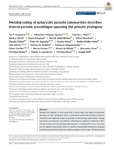Metabarcoding of eukaryotic parasite communities describes diverse parasite assemblages spanning the primate phylogeny
Gogarten, Jan F.
Calvignac-Spencer, Sébastien
Nunn, Charles L.
Ulrich, Marcus
Saiepour, Nasrin
Vedel Nielsen, Henrik
Deschner, Tobias
Fichtel, Claudia
Kappeler, Peter M.
Knauf, Sascha
Müller-Klein, Nadine
Ostner, Julia
Robbins, Martha M.
Sangmaneedet, Somboon
Schülke, Oliver
Surbeck, Martin
Wittig, Roman M.
Sliwa, Alexander
Strube, Christina
Leendertz, Fabian H.
Roos, Christian
Noll, Angela
Despite their ubiquity, in most cases little is known about the impact of eukaryotic parasites on their mammalian hosts. Comparative approaches provide a powerful method to investigate the impact of parasites on host ecology and evolution, though two issues are critical for such efforts: controlling for variation in methods of identifying parasites and incorporating heterogeneity in sampling effort across host species. To address these issues, there is a need for standardized methods to catalogue eukaryotic parasite diversity across broad phylogenetic host ranges. We demonstrate the feasibility of a metabarcoding approach for describing parasite communities by analysing faecal samples from 11 nonhuman primate species representing divergent lineages of the primate phylogeny and the full range of sampling effort (i.e. from no parasites reported in the literature to the best‐studied primates). We detected a number of parasite families and regardless of prior sampling effort, metabarcoding of only ten faecal samples identified parasite families previously undescribed in each host (x̅ = 8.5 new families per species). We found more overlap between parasite families detected with metabarcoding and published literature when more research effort—measured as the number of publications—had been conducted on the host species' parasites. More closely related primates and those from the same continent had more similar parasite communities, highlighting the biological relevance of sampling even a small number of hosts. Collectively, results demonstrate that metabarcoding methods are sensitive and powerful enough to standardize studies of eukaryotic parasite communities across host species, providing essential new tools for macroecological studies of parasitism.

